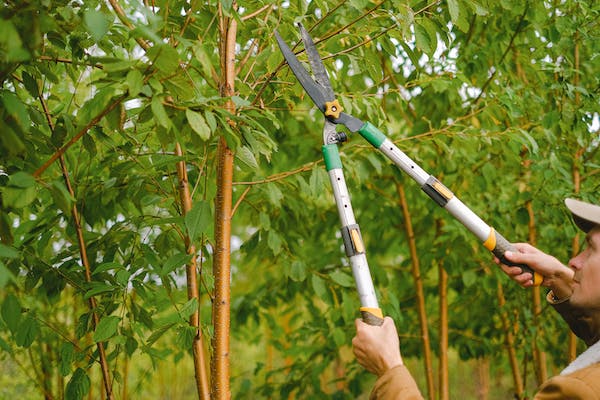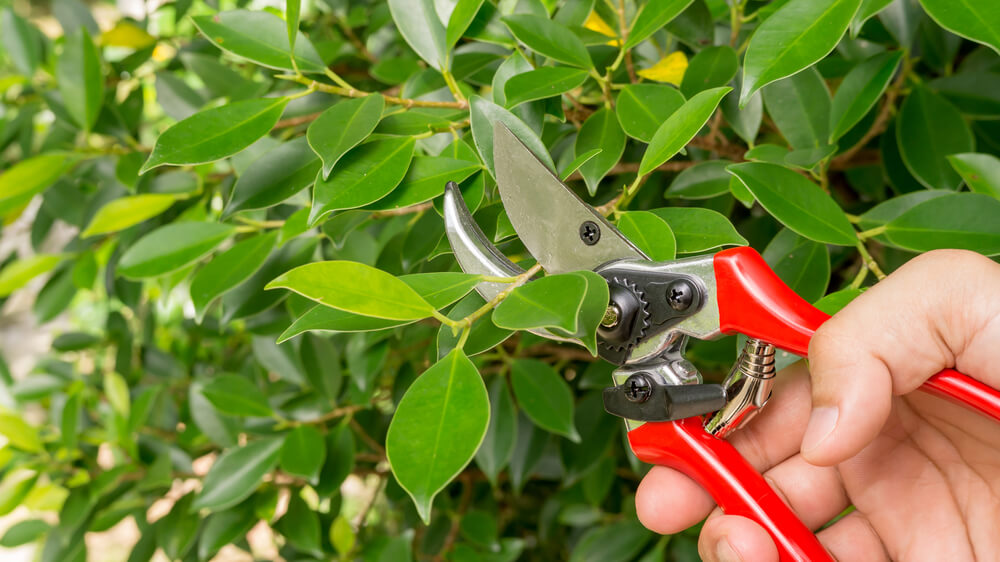Because ficus plants proliferate, even indoors, they will increase in size. While this is fantastic for owners who want a large and robust Ficus in their house, there is one issue: what happens when a Ficus plant surpasses its container?
Fortunately, your ficus will likely overflow its container solely on the outside (its leaves). Because the roots develop slowly, you can report less frequently.
On the other hand, regular pruning is one of the fundamental skills you must master if you want to grow Ficus trees in your home.
This guide explains how and when to prune a ficus tree.
Stay with me.
5 Simple Ways to Pruning Your Ficus Tree
Before Handling Your Ficus, Put On Gardener Protective Gear.

Most ficus species expel a toxic concentration of solutes that causes skin discomfort. Thus, remember to wear sturdy gloves when pruning your ficus to avoid rashes.
Gloves made of latex or lightweight textiles will not safeguard you from the sap of the ficus. Thick gardening gloves are available at most plant nurseries and hardware stores.
Examine Your Tree for Any Fading or Dead Branches.

If you discover any sick, broken, or dead branches, use your needle-nose pliers or shears to cut them off at a downward slant. Cut the injured stem into a distinct region to assist your tree’s repair and focus its vitality on healthy branches.
Dead or dying branches commonly have gray or decomposing wood and lose their bark.
To Promote Fuller Development, Prune Above Leaf Scars.
Inspect your ficus tree for scars where the leaflets used to be if they have dwindled out more than usual. Cut just above leaf scars to stimulate fuller growth as your plant matures.
Leaf scars are little, circular markings that appear where your plant once had leaflets. They usually have a lighter tint than the adjoining branch. Pruning over leaf scars is best done in the spring.
Apply the Cut Paste to Heavily Trimmed Regions.
Spread the cut plaster over the trimmed area if you prune back huge branches or make multiple cuts. Because pruning causes many corneal abrasions, the cut dressing will help the tree heal and protect it from pests and diseases.
Immediately Discard Ficus Clippings After Pruning.

Due to the toxicity of ficus plants, their scraps cannot be used as fertilizer or compost. When you’re finished pruning, collect the chunks in a garbage bag and dispose of them.
Ask local recycling centers if they may utilize your ficus cuttings as an environmentally acceptable alternative.
Choosing When to Prune Your Ficus Plant
When should you prune your ficus? Trim your plant if it comes into contact with your home’s furniture, ceiling, or other things. You are pruning your ficus plant after a few growing seasons benefits it in several ways.
Here are some periods of the year when you should prune your ficus plant.
1. In the Late Summer, Early Fall, or Early Spring (Trim Outside Ficuses)
Outdoor ficuses may typically be trimmed throughout the year and are relatively flexible. The best time to prune your ficus is any time between late summer and early spring because this is when it will be growing dormant.
Avoid pruning an outdoor tree in the early summer, as this might cause a growth surge in the off-season, making your plant more susceptible to frost.
2. In the Summer, Fall, or First Part of the Spring (Prune Indoor Ficuses)
Indoor ficuses require constant pruning to eliminate old leaves and shape the plant. When your indoor ficus produces new leaflets and buds in the middle of spring, avoid pruning it.
3. Shape Ficuses During the Winter.
Before performing any significant shaping, please wait until your plant is in its winter dormancy. When it comes to external plants, you’ll be able to see the branch structure better, and your plant will be less prone to suffer from pruning shock.
4. Remove Diseased, Damaged, or Dead Branches Whenever Possible.
Dying or dead limbs can destabilize your tree and expose it to additional harm. To avoid this, cut broken branches as soon as you discover them.
Remove no more than one-third of the foliage if your Ficus plant is seriously damaged and has a lot of dead growth.
More pruning can always be done later once the tree has recovered. It is better to wait until your ficus tree sprouts. In this manner, you can ensure that no fresh material is removed.
5. Prune Your Ficus in the Spring if You Want It to Grow Fuller.

Pruning can encourage branching if you’ve discovered overly thin sections on your ficus. Trim the ficus during early spring to promote branch and foliage growth the following season.
If you see thinning in the summer or early fall, postpone trimming until the following season.
Wrapping Up
Pruning the Ficus plant is not difficult, but you must be careful not to harm your plant. It is advisable to use a sharp, clean pair of pruners. Bypass pruners are the most effective.
Also, remember to use gloves, so you don’t injure yourself while trimming. Remember that Ficus plants produce latex sap that can irritate the skin.








